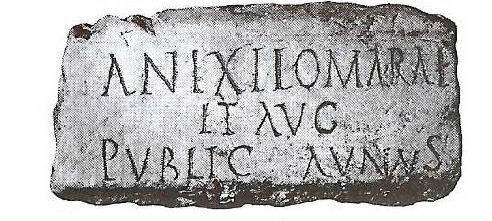1) Protection
a) Anextlomara (‘the Great Protectress’)
Protection is personified by the goddess Anextlomara, who is known from a single inscription, dating between the 1st and 3rd c. AD, discovered in Aventicum (Avenches, Switzerland), the capital of the tribe of the Helveti: Anextlomarae et Aug(usto) Public(us) Aunus, ‘To Anextlomara and to August, Publicus Aunus’ (fig. 18).1471 The dedication was found in a context of a habitation, which points to a domestic cult.1472 Anextlomara is associated with the imperial cult of the Emperor Augustus and the dedicator bears the duo nomina of Roman citizens. Her name is indeed composed of anextlo-, anexto- signifying ‘protection’ and maro-, ‘great’, ‘big’.1473 Anextlomara is therefore ‘the Great Protectress’ or ‘With Great Protection’. Her name is the feminine version of the epithet given to Apollo Anextlomarus, the ‘Great Protector’, venerated in South Shields (GB) and Le Mans (Sarthe).1474 The discovery of the dedication in a domestic context tends to prove that Anextlomara was a guardian ensuring the safety and prosperity of the people in their everyday lives, at home and at work. She might also have brought protection to the inhabitants in time of conflict or war, but no archaeological data is available to corroborate such a hypothesis.
